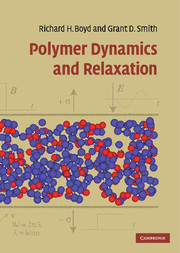9 - Semi-crystalline polymers
Published online by Cambridge University Press: 10 November 2009
Summary
Long polymer chains consisting of identical monomeric units are, in principle, capable of being organized into crystalline arrays. Usually the chains are parallel bundles and the unit cell is based in some elementary way on the monomeric repeat unit. However, because of their great chain lengths it is kinetically difficult for polymers to form large crystals or to crystallize completely. In the case of quiescent crystallization from the melt the common morphology involves very thin lamellar crystals in which the crystallizing chains fold back and forth across the growth face. A given chain may be incorporated into several lamellae where the latter are organized in ribbon-like sheaves. It is inevitable that a considerable fraction of chain units will be constrained from being laid down on the growth faces. An appreciable fraction of uncrystallized material results. The local organization is that of stacked lamellae separated by amorphous layers (Figure 9.1). Thus crystallizable polymers are typically semi-crystalline two-phase systems. The degree of crystallinity, i.e., the volume of the crystal phase relative to the specimen volume can vary according to the crystallization conditions. Slow cooling versus rapid quenching, annealing etc. are typical variables. Higher degrees of crystallinity tend to be accommodated by thicker crystal lamellae with a relatively minor role for the amorphous interlayer thickness.
Questions of interest that arise are the following. To what extent does the amorphous fraction in a semi-crystalline environment resemble the bulk amorphous phase in respect to its relaxation behavior?
- Type
- Chapter
- Information
- Polymer Dynamics and Relaxation , pp. 199 - 226Publisher: Cambridge University PressPrint publication year: 2007

